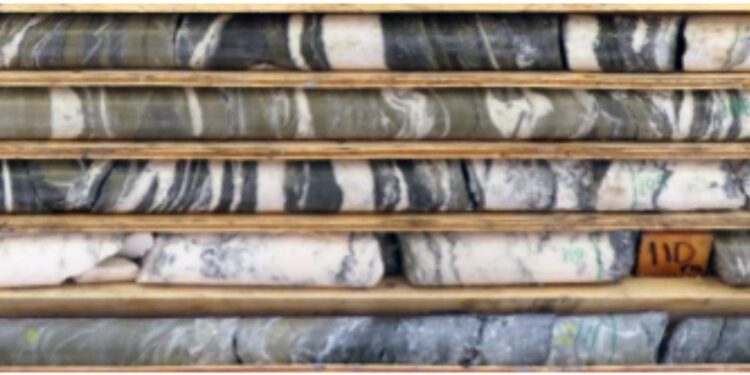Snowline Gold Corp. (CSE: SGD) has received high-grade assay results from Phase I drilling at the Jupiter zone on its district-scale Einarson gold project in the Yukon Territory, Canada.
Among these results, hole J-21-020 returned 8.3 g/t Au over 4.7m, including 22.1 g/t Au over 1.1m in a quartz-carbonate vein breccia carrying visible gold. True widths for this intersection are not known but are estimated at approximately 90% of the reported interval.
The wide, stylolitic, acicular arsenopyrite-bearing quartz carbonate vein breccia from 108.9 m to 110.0 m downhole returned 22.1 g/t Au over 1.1 m. I
nstances of fine-grained visible gold were observed at 109.6 m and 109.8 m downhole. This sits within a broader zone of mineralised quartz carbonate veins and pyrite-and arsenopyrite-bearing siltstones from 106.0 m to 110.7 m downhole which averaged 8.3 g/t Au (including the above interval). Intersections are perpendicular to the core axis and thus suggest a close approximation of true widths, although the geometry of the mineralisation is not yet known.
“We are pleased to see high grades associated with the visible gold discovered in this new part of the Jupiter zone,” said Scott Berdahl, CEO and Director of Snowline Gold Corp.
The vast majority of the 3 km Jupiter zone anomaly remains to be tested, within and outside of the 1.1 km area drilled to date. Inset shows Jupiter and surrounding zones in context of local geology and major faults. Snowline’s 2021 drill campaign is the first ever drill testing of Jupiter on the district-scale Einarson gold project. True widths of the above intervals are not yet known.
“While the area lacks mineralised outcrops to guide our decision-making at Jupiter, this target was particularly blind but it does have a broad geochemical anomaly. As a random shot through this target, today’s results are particularly encouraging – they give us a foot in the door in locating and delineating this new mineralisation centre.
“With results from widely space drilling over 1.1 km we are just scratching the surface. We look forward to expanding on this discovery and others as we further test the 3-km-long geochemical anomaly at Jupiter in the upcoming 2022 field season.”
The bottom of hole J-21-016 returned 0.95 g/t Au over 4.5 m from 175.8 m downhole. Holes 17 through 19 were drilled to test a possible parallel trend to the discoveries in holes 10-13 and 15, and they intersected grades of up to 3.2 g/t Au. Hole J-21-021, which was drilled at a steeper angle from the same pad as Hole 20, intersected a large pyritic zone with quartz carbonate material but generally subdued gold values.
This Phase I drill programme represents the first ever drilling at Jupiter and marks the discovery of a new style of mineralisation for this region of the Yukon. Jupiter is thought to represent an epizonal orogenic gold system, with similarities to systems like New Found Gold Corp.’s Queensway discoveries in Newfoundland and Agnico Eagle Mines Ltd.’s Fosterville mine in the Bendigo district of Australia.
Jupiter is one of nine target zones prospective for orogenic and/or Carlin-style gold mineralisation currently recognised on Snowline Gold’s 70%-owned, district-scale Einarson project. Adjacent projects Rogue and Ursa are prospective for intrusion-related gold and sediment-hosted gold and base metal deposits.
For further information please visit: https://snowlinegold.com/












